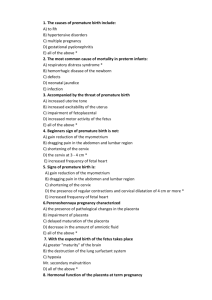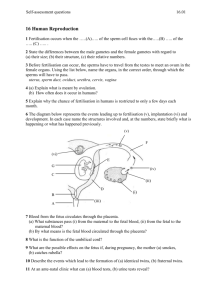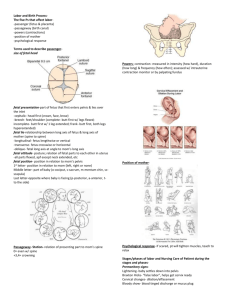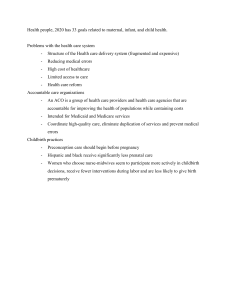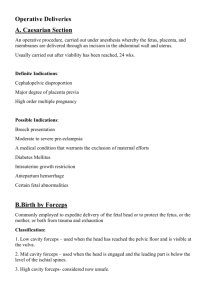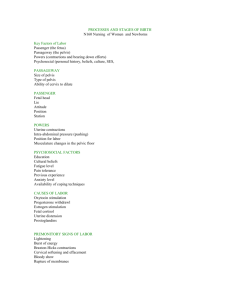Select the best answer : (10 Mark)
advertisement
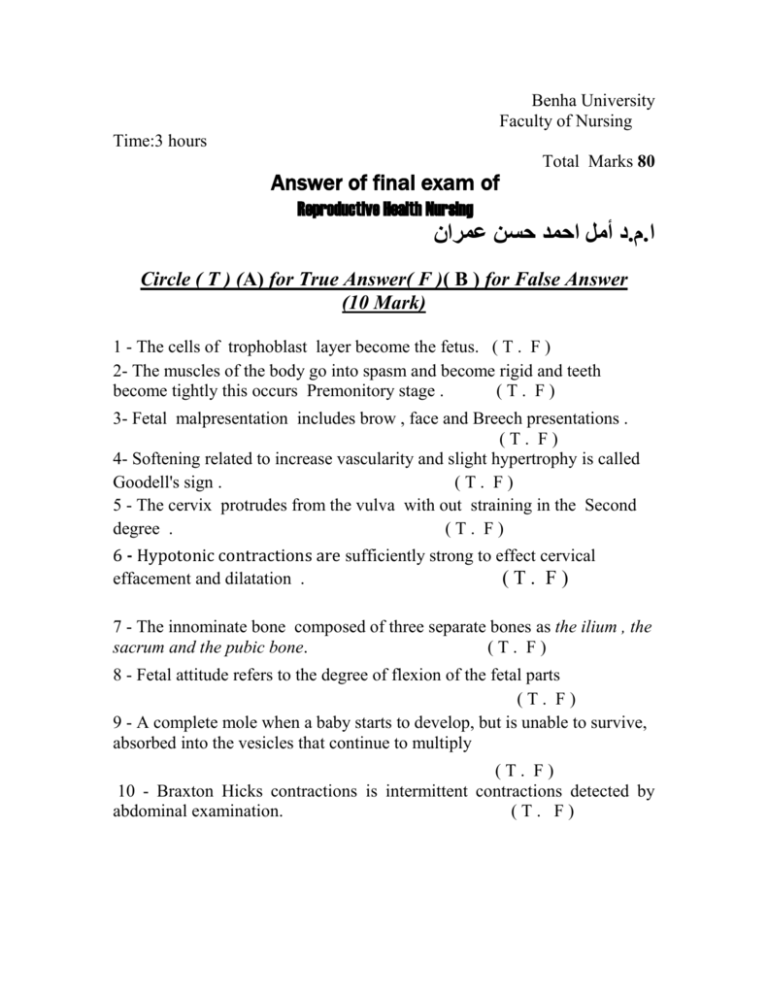
Benha University Faculty of Nursing Time:3 hours Answer of final exam of Total Marks 80 Reproductive Health Nursing د أمل احمد حسن عمران.م.ا Circle ( T ) (A) for True Answer( F )( B ) for False Answer (10 Mark) 1 - The cells of trophoblast layer become the fetus. ( T . F ) 2- The muscles of the body go into spasm and become rigid and teeth become tightly this occurs Premonitory stage . (T. F) 3- Fetal malpresentation includes brow , face and Breech presentations . (T. F) 4- Softening related to increase vascularity and slight hypertrophy is called Goodell's sign . (T. F) 5 - The cervix protrudes from the vulva with out straining in the Second degree . (T. F) 6 - Hypotonic contractions are sufficiently strong to effect cervical effacement and dilatation . (T. F) 7 - The innominate bone composed of three separate bones as the ilium , the sacrum and the pubic bone. (T. F) 8 - Fetal attitude refers to the degree of flexion of the fetal parts (T. F) 9 - A complete mole when a baby starts to develop, but is unable to survive, absorbed into the vesicles that continue to multiply (T. F) 10 - Braxton Hicks contractions is intermittent contractions detected by abdominal examination. (T. F) The answer : 1-F 2-F 3-F 4-T 5-F 6- F 7-F 8-T 9-F 10 - T Complete the following : (20 Marks ) 1)Shape of Hymen: annular-crescent-cribriform- Elastic - imperforate 2) The hilum where the vessels enter lies just where the ovary is attached to the broad ligament and this area is called mesovarium 3)The vaginal walls stretch during child birth due to folds as rugae 4) Factors affecting the process of normal labor passages, passengers and power 5) The fetal head is composed of several bones as two frontal bones, two temporal bones, two parietal bones, and the occipital bone). 6)The last menstrual period 16/1/2011 determine expected date of delivery? 22 / 8 / 2011 +-15 days 7) Anterior vaginal prolapse is called (Cystocoele) GATHER in family planning means : 1- G greet client in a friendly and helpful way 2- A ask client about their family planning needs. 3- T tell clients about available family planning methods. 4- H Help clients choose a method. 5- E Explain how to use the method chosen. 6 - R Return for follow up. Select the best answer : (10 Mark) 1- The embryo blast is : A) the blastocyst B) the outer cell mass C) the inner cell mass 2- The cervix protrudes from the vulva on straining A) First degree b)Second degree c) Third degree 3 - A term used to describe any difficulty or interference in the normal labor process is: a. Uterine inertia. c. Latency. b. Uterine dysfunction. d. Dystocia 4- When caring for a woman who develops prolapsed of the umbilical cord, a nurse should: a. Elevate the head of the bed. b. Elevate the foot of the bed. c. Push the presenting part upward. d. Push the exposed cord back. 5- Where a baby never develops, but the placenta implants and grows many small cysts, like sacs filled with fluid. a- A complete mole b- A partial mole c- Palpable cystic ovaries. d- All except c 6- Female Methods of contraception include: a - Gossypol b- Intrauterine Peccary c-Vasectomy 7- Female causes of infertility a- Oligoovulaiton b- Hypospadias c- retrograde ejaculation 8- Inability to conceive and to continue pregnancy to get a live-born baby after one year of regular intercourse without contraception methods. a-Infertility b-Sterility c-Relative infertility 9- Mothers are restless and rapid eye movement, and twitching of facial muscles occur in A) Premonitory stage B) Tonic stages C) Clonic stages 10- The lower placental edge lies within 2 cm of the internal os but does not cover it a) Low lying placenta b) Marginal previa c) Complete previa The answer : 1: c 2: b 3:d 4:b 5:a 6:b 7:a 8:a 9:a 10:b IV- Give the suitable meaning of the following sentences: (20 Marks 1) contains the ovarian follicles in different stages of development, surrounded by stroma. ( The cortex ) 2 ) gradual increase in the amount of non irritating vaginal discharge due to estrogen stimulation of cervical mucous ( Leukorrhea ) 3) a baby starts to develop, but is unable to survive, often being absorbed into the vesicles that continue to multiply. ( A partial mole ) 4) Bleeding occurs within the uterus and does not leave the cervix. Concealed placenta abruption ( ) 5) The lower placental edge lies within 2 cm of the internal os but does not cover it. ( Marginal previa ) 6) Severe form of preeclampsia associated with hemolysis , elevated liver enzymes and low platelet count less than 100.000 mm3. ( HELLP syndrome ) 7) Bp <160 / 110 mmHg, with proteinuria or edema ( Moderate Preeclampsia ) 8) Tube that carries the sperm out of the scrotal sac ( vas deference ) 9- composed of four bones as two innominate bones, one sacrum and one coccyx . ( Bony pelvis ) 10- Strong , frequent and painful contractions but are uncoordinated ineffective in accomplishing cervical effacement and dilatation. ( Hypertonic contractions ) III-Matching the following: (10 Marks) 1- The denominator is occiput a) In occipital posterior position 2- The denominator is sacrum b) In vertex presentation 3- The denominator is chin. c) In brow presentation 4- The denominator is frontal bone d) In face presentation 5- the vertex presentation changes to e) In breech presentation posterior position during internal rotation f ) In shoulder presentation The answer : 1 2 3 4 5 b e d c a Discuss the following briefly : (10 Marks) 1 - Characters of normal labor 2- kinds of placenta abruptio 3- Stages of an eclamptic fits 4- Complications Diabetes mellitus during pregnancy 5- Degree of heart disease during pregnancy The answer : 1 - Characters of Normal labor : The process, which the fetus is born at full term (> Completed 37 weeks) The fetus is living. The fetal presentation is vertex. The process of labor is completed spontaneously. The process of labor is completed through the natural passages. The time of labor does not exceed 24 hours. Regular uterine contractions Dilatation of the cervix. Descent of the presenting part Without complication to the fetus and mother. 2- kinds of placenta abruption Relating to where the bleeding occurs: A- Concealed : This form means that bleeding occurs within the uterus and does not leave the cervix. B- Visible In this form, blood drains through the cervix and out of the body. 3 - Stages of an eclamptic fits : A. Premonitory stage: (less than 10-20 seconds). Mothers are restless and rapid eye movement, the head may be drawn to one side and twitching of facial muscles occur. B. Tonic stages: (lasts 10-20 second). The muscles of the body go into spasm and become rigid and her back become arched, teeth become tightly clenched and eye staring. C. Colonic stages: (lasts 60-90 seconds). Salivation increases and foaming at the mouse occurs the mother bites her tongue during this episode, face becomes congested, she is unconscious, and gradually convulsion subsides. D. Stage of coma: Torturous breathing continues and coma may persist for minutes or hours, further convulsions may occur before the mother regain consciousness. 4- Complications Diabetes mellitus during pregnancy : Maternal : 1. Increased incidence of abortion 2. Increased incidence of preeclampsia 3. Increased incidence of prenatal mortality and morbidity 4. Preterm labour 5. Polyhydrominos 6. Infection Fetal : 1. Hypoglycemia or hyperglycemias 2. Intrauterine growth restriction 3. Intrauterine fetal death 4. Neonatal hyperbilirubinemia 5- Degree of heart disease during pregnancy: Grade I: No symptoms or signs as (excessive fatigue, palpitation, dyspnea or anginal pain) with normal physical activity. Grade II: minor symptoms & signs with normal physical activity. Grade III: marked symptoms & signs present with limited activity. Grade IV: symptoms & signs present at rest, Discomfort increase with any kind of physical activity.

